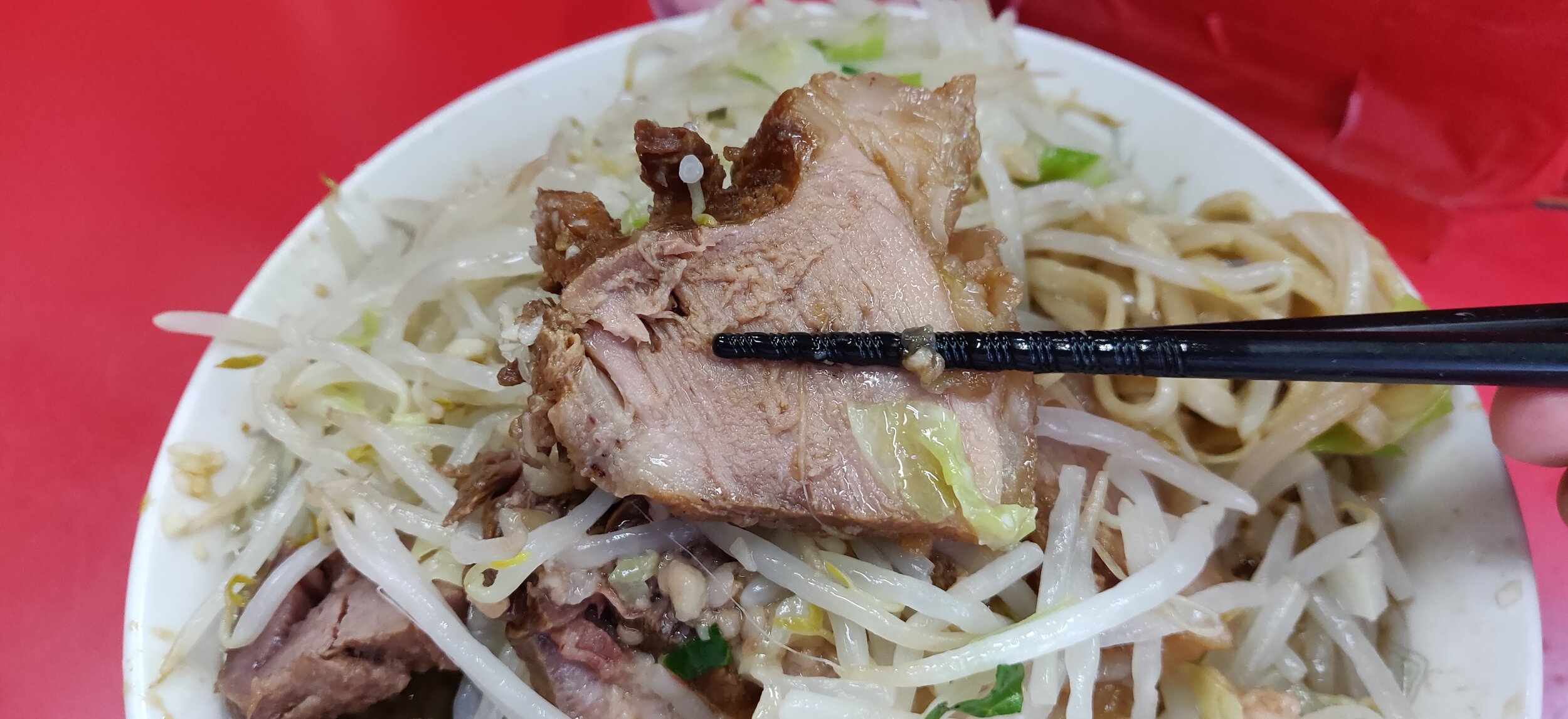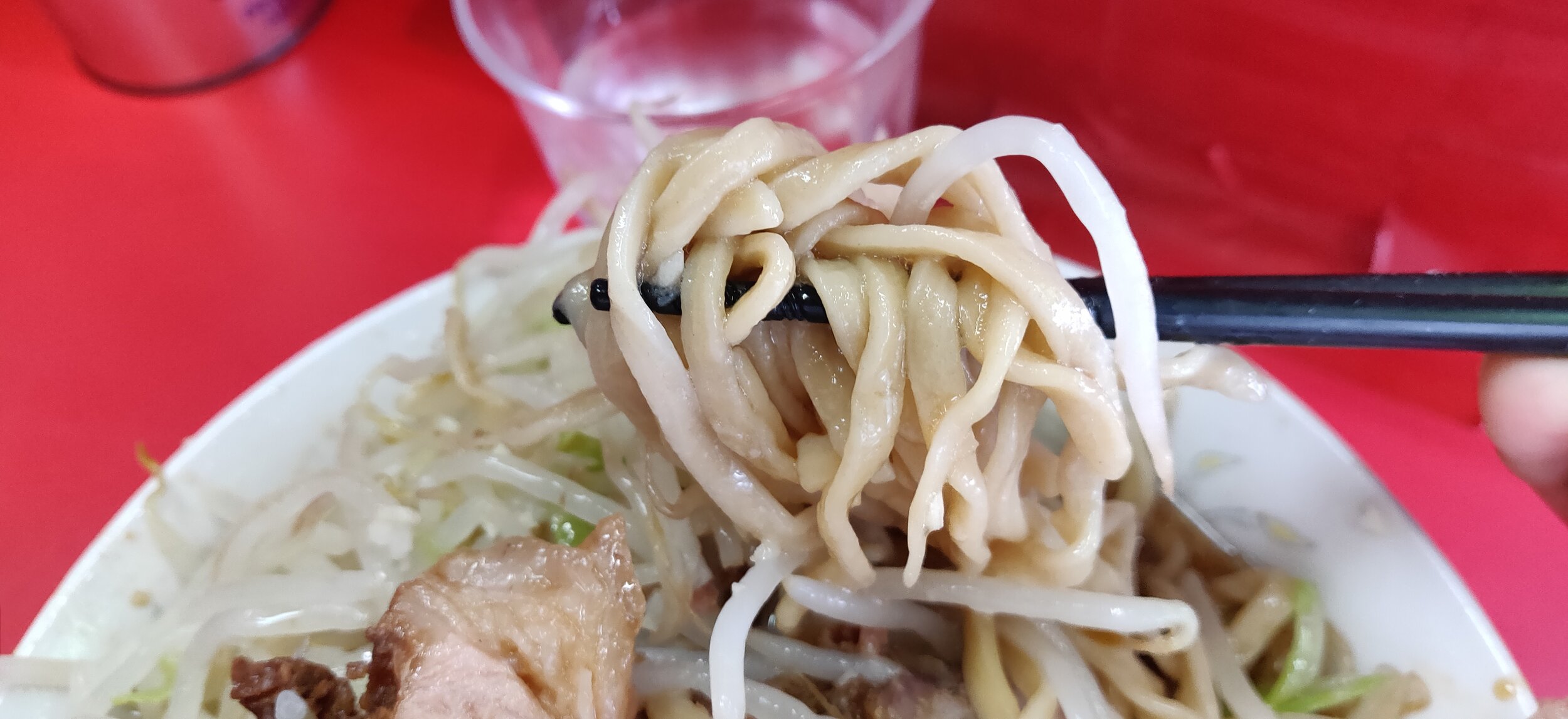Ramen Jiro Mita Honten (ラーメン二郎三田本店); Original Jiro, Mita, Tokyo
Ramen Jiro is an institution that has garnered a huge fan base to a near cult status and originated from the owner of this location in Mita, right near Keio University. Ramen Jiro actually began in 1968 near Toritsu Daigaku station in Meguro, but moved to this location in the 1970s which brought along this infamous sign. The story goes that the sign maker used the wrong kanji (Chinese characters) for the banner and the Master here couldn't be bothered to change it back, hence this kanji style for the shop name which has carried over to the other branches. Currently Jiro operates in 39 different franchise locations around Japan with countless other Jiro “inspired” restaurants, which have no connection with the 39 Jiro, but try and emulate this ramen style. A majority of the people who run these Jiro inspired ramen shops started off as a “Jirorian”, or a Jiro obsessive who have an innate love for the Jiro brand. If you know me or follow my instagram, you’ll know that I too am a Jirorian having gone to about half of the Jiro franchise locations and making an effort to to eat at the other half. Of the locations I’ve gone to so far, this Mita location has a special place in my heart as it was my second Jiro ever and the closest to my work place so it gives me great pleasure to finally write a review for this infamous ramen shop. So without further ado, here is my review for the classic shop, Ramen Jiro Mita Honten.
Much like all the other Jiro locations, Mita Honten has quite the small menu. Don’t let the lack of menu options fool you however as they serve up some of the most voluminous ramen in all of Japan. Once you get to the shop, make your way to the ticket machine to purchase your ticket before you stand at the back of the line. Starting with the dark blue button on the top left the menu goes Ramen, Buta Ramen (extra pork char siu), and Buta Double Ramen (double portion of pork char siu). The second row is the Dai Ramen, or large ramen starting with Dai Ramen (large ramen), Buta Iri Dai Ramen (extra pork char siu large ramen), and the Buta Double Dai Ramen (double portion pork char siu). If you’ve read my past Jiro reviews you know already that the large double pork ramen is not for first timers and the owner here will strongly discourage you from ordering it your first time. Unlike other Jiro locations however, the master here won’t restrict you from ordering it so if you really feel the hunger to go for the large, it is an option. If you end up leaving a significant amount of food, be sure not to show your face again, the master here is known to remember those who fail to finish despite his warnings. Once you have your ticket, go back to the end of the line and wait for a seat to open. If it gets busy, the chef or his assistant will ask you what you ordered. Just flash your ticket to the chef if you’re not confident in your Japanese, but if you are, feel free to let him know verbally. When a seat opens up, one of the assistants will let you know where to sit and you’ll place your ticket on the top counter. Wait for the chef to cook up your ramen and once he’s finished he’ll as you “Ninnikuwa?”, which is the signal for the which toppings you want and how much. Yasai (vegetables consisting of blanched cabbage and bean sprouts), Ninniku (pressed garlic), Abura (pork fat), and Karame (seasoning sauce) are all free of charge and when the chef asks what you’d like, you call out which toppings you would like and how much of each. If you say each topping, you will get an average amount of those toppings. If you want a little extra of a certain topping, you can say “Mashi” after which ever topping you want more of. “Mashi-Mashi” will be even more of said topping. So for instance, if you wanted no garlic, extra vegetables, and normal pork fat and seasoning sauce, you would say “Yasai mashi, abura, karame”. If you want extra of all the toppings you can say “Zen-Mashi”, or everything extra. I opted to order the Sho Ramen with four slices of pork char siu and asked for “Yasai, Ninniku, Abura” for a bit extra of veggies, garlic and pork fat.
I opted for the Buta Ramen, or regular ramen with extra pork and asked for zenmashi. The photo’s depth perception is a bit off so you’ll just have to take my word for it when I sat that this was an incredibly filling bowl. I actually struggled to walk back to the station because of how much I had eaten on this visit. Anyways, before even receiving your bowl, be sure to watch as the chef and his assistants conjure up your bowl. Watching the chef prepare the ramen is a show in and of itself. While throwing handfuls of noodles in to the boiling cauldron, the master will fill each bowl with the tare seasoning sauce which he scoops out of the pork char siu containers that soak it up in the meantime. In addition to the tare, he puts in what is known as gurue-su, or Japanese MSG. Yup, Jiro adds a nice heaping spoonful of MSG to the soup to create the umami flavor in the ramen. Don’t get me started if you’re anti-MSG as the whole myth behind the headaches and cancer has been disproven many times over, but if you’re still worried, this is definitely not the bowl for you. When the master prepares the bowl, he makes no effort in hiding the amount of MSG he throws in there and to be honest, Jiro broth isn’t the healthiest anyway, so if you’re still concerned that the MSG will make it bad for you, you’re in for a bad time.
While we’re on the subject of soups, the broth is a combination of a variety of vegetables mixed with heaps of pork bones and pork back fat. The pork fat topping you get is actually the rendered pork fat that results from it simmering in the soup and it adds the distinct oiliness to the soup. It depends on the location, but the places that render them down longer will tend to have the more emulsified soup while the ones like this original location will have a more oily soup. It comes down to personal preference, but people will say the oily one is harder to take down, but easier to digest. Anyways, after pouring the MSG and seasoning sauce, the chef will then fill the bowl with this fatty soup, and finally place the noodles inside.
It’s actually kind of entertaining how the chef throws the noodles in as he doesn’t weigh or portion them out before boiling like you see at more typical shops. He boils about four to five bowls worth of noodles at a time and he’ll literally throw in noodles in to the cauldron based on feel and how much noodles he thinks he’ll needs for each bowl. I wish I could tell you that he’s a savant that just knows how much noodles he grabs, but most Jirorians will tell you that sometimes you get more and sometimes you get less…all just depends on how the chef is feeling in terms of noodle portions that day. After getting the bowl made, he’ll top it off with the toppings you called for and place it in front of you.
The two biggest selling points of Jiro is the noodles and pork char siu. First off, the noodles. Noodles at Jiro is incredibly unique as it is dense and chewy, unlike any other ramen shops I’ve ever been. The low water content and alkalinity adds to the chewiness, but also gives it a sponge like aspect to it in which it starts soaking up a lot of the soup as it sits in the bowl. Most shops tend to make sure the noodles don’t do this as they don’t want soggy, wet noodles in their bowl, but Jiro really embraces this, even at times to the point where certain Jiro locations will overcook their noodles so it comes out soggy to begin with. For most ramen, I’d think it would be counter intuitive to have soggy, sponge like noodles, but since the soup at Jiro is incredibly unhealthy and shouldn’t be drank on its own, it’s the perfect way to have the soup without the intense saltiness you’d get just by scarfing it down by itself.
Next off, the pork char siu. The pork char siu is different at each location depending on the cooking and preparation style. Some places will simmer the pork char siu in the soup, others will cook it separately. Some locations will marinate the pork in with the tare seasoning sauce, while others will marinate them in a different container. The Jiro here cooks their pork with the soup and marinates it in with the tare seasoning. It makes the flavors way stronger and you’ll get a lot more tender, but fibrous meat slices. There isn’t a huge fat content on the pork slices at this Honten so it makes a perfect pairing with the dense noodles and oily soup. It’s definitely worth it to pay the extra 100 yen for extra pork slices, and since the ramen is already cheap as it is, it’s not gonna break the bank for you to splurge so I highly recommend coughing up the dough for.
The combination of flavors and components of the ramen at Jiro is the biggest drawing point for Jirorians as each individual aspect is pretty grotesque at its core. The pork heavy soup is incredibly oily and very unhealthy, the soup soaking noodles are quite unusual, and the pork slices are meaty and chewy than melt in your mouth. Vegetable toppings of cabbage and bean sprouts seem mundane, with the pork fat seemingly excessive, but honestly all of these combined is what makes Jiro special. Each Jiro location has these basics components, but will make slight changes that results in small differences that make people choose one over another. However, the honten lovers will tell you, the original recipe combined is the only true Jiro and the one all Jirorians will agree as one of the bests. While it may not be everyone’s favorite, everyone has the respect and appreciation for what this location has done for the ramen industry. I highly urge you to do the same and have a try at this original Jiro location. You’ll be having a taste of history and you may end up becoming a Jirorian like myself.




